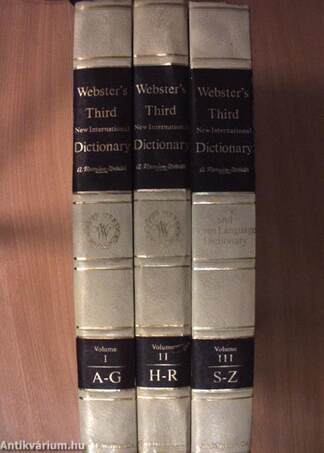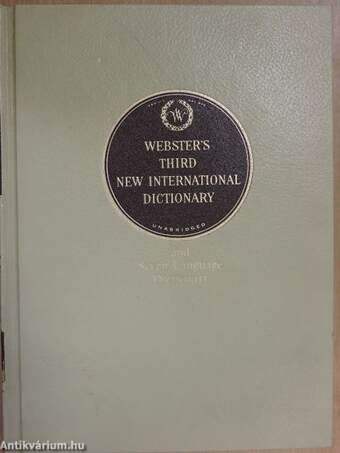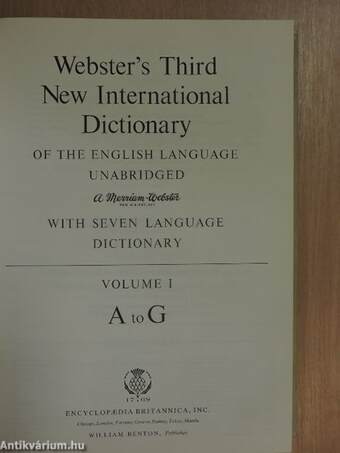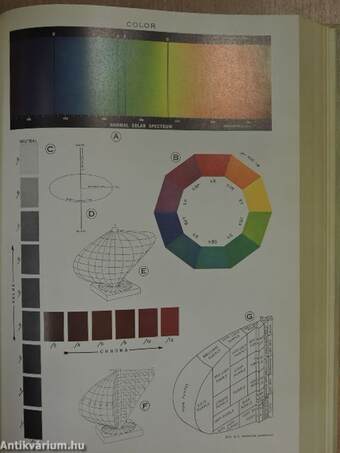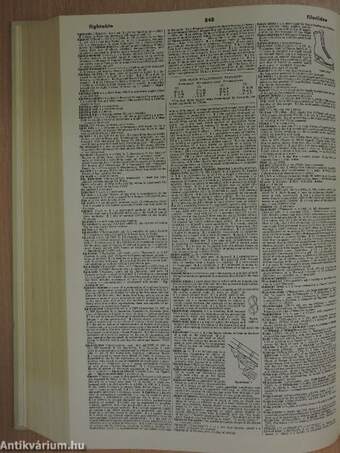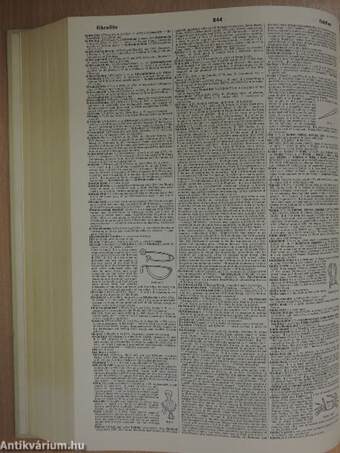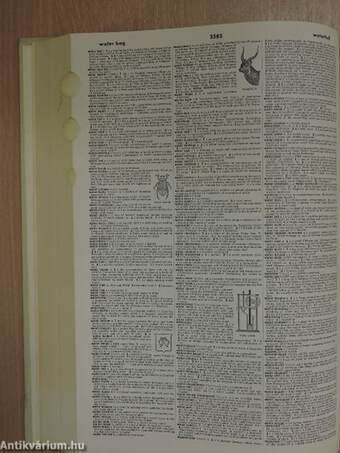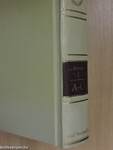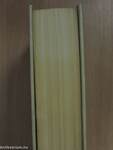1.068.029
kiadvánnyal nyújtjuk Magyarország legnagyobb antikvár könyv-kínálatát

VISSZA
A TETEJÉRE
JAVASLATOKÉszre-
vételek
Webster's Third New International Dictionary of the English Language Unabridged I-III.
Volume I: A to G/Volume II: H to R/Volume III: S to Z/With seven Language Dictionary
| Kiadó: | G. & C. Merriam Company |
|---|---|
| Kiadás helye: | Springfield |
| Kiadás éve: | |
| Kötés típusa: | Fűzött keménykötés |
| Oldalszám: | 3.135 oldal |
| Sorozatcím: | |
| Kötetszám: | |
| Nyelv: | Angol |
| Méret: | 33 cm x 24 cm |
| ISBN: | 0-87779-206-2 |
| Megjegyzés: | 1768-ban az Encyclopaedia Britannica, Inc. által kiadott mű reprint kiadása. Fekete-fehér és színes illusztrációkkal. A III. kötet végén francia, német, olasz, spanyol, svéd és jiddis szószedettel. További kapcsolódó személyek a kötetben. A III. kötet regiszteres kiadás. |
naponta értesítjük a beérkező friss
kiadványokról
naponta értesítjük a beérkező friss
kiadványokról
Előszó
Webster's Third New International Dictionary is a completely new work, redesigned, restyled, and reset. Every line of it is new. This latest unabridged Merriam-Webster is the eighth in a series... Tovább
Előszó
Webster's Third New International Dictionary is a completely new work, redesigned, restyled, and reset. Every line of it is new. This latest unabridged Merriam-Webster is the eighth in a series which has its begin-ning in Noah Webster's American Dictionary of the English Language, 1828. On Webster's death in 1843 the unsold copies and publishing rights of his dictionary were acquired by George and Charles Merriam, who in 1847 brought out a revision edited by Noah Webster's son-in-law, Professor Chauncey A. Goodrich of Yale College. The 1847 edition became the first Merriam-Webster unabridged dictionary*. G. C. Merriam Company now offers Webster's Third New International Dictionary to the English* speaking world as a prime linguistic aid to interpreting the culture and civilization of today, as the first edition served the America of 1828.
As the number of students in school and college jumps to ever-increasing heights, the quantity of printed niatter necessary to their education increases too. Not only are more words used more often with these increases; words must be used more economically and more efficiently both in school and out. More and more do people undertaking a new job, practicing a new hobby, or developing a new interest turn to how-to pamphlets, manuals, and books for both elementary instruction and advanced guidance. Where formerly they had time to learn by doing, they now need to begin by reading and understanding what has been recorded. A quiek grasp of the meanings of words becomes necessary if one is to be successful. A dictionary opens the way to both formai learning and to the daily self-instruction that modern living requires. It is the key alsó to the daily newspaper and to a vast number of other periodicals that demand our attention. This edition has been prepared with a constant regard for the needs of the high school and college student, the technician, and the periodical reader, as well as of the scholar and professional. It undertakes to provide for the changes in public interest in all classes of words as manifested by what people want to read, discuss, and study. The dictionary more than ever is the indispensable instrument of understanding and progress.
G. C. Merriam Company have produced this Third New International at a cost of over $3,500,000. The budgetary and technical planning underlying its production has been directed and coordinated since 1953 by the Company's president, Mr. Gordon J. Gallan. His activity, understanding, and cooperation have contributed indispensably to its editorial comple-tion and have made possible the maintenance of a Merriam-Webster perma-nent office staff constituted according to need. This staff is in effect a faculty which specializes in different branches of knowledge much as a small college faculty does. Listed among the resident editors are a mathematiciaTi, a physicist, a chemist, a botanist, a biologist, a philosopher, a political scien-tist, a comparative religionist, a classicist, a histórián, and a librarian as well as philologists, linguists, etymologists, and phoneticians whose specialty is the English language itself. Their academic affiliations and their degrees can be seen one by one in the "Merriam-Webster Editorial Staff" that follows this preface. Besides the office staff over two hundred other scholars and specialists have served as outside consultants in supplementary reviewing, revising, and submitting new definitions in subjects in which they are authorities. The rangé and experience of this special knowledge appear in the listing of their names alphabetically after the editorial staff.
In conformity with the principle that a definition, to be adequate, must be written only after an analysis of usage, the definitions in this edition are based chiefly on examples of usage collected since publication of the pre-ceding edition. Members of the editorial staff began in 1936 a systematic reading of books, magazines, newspapers, pamphlets, catalogs, and learned journals. By the time of going to press the collection contained just under 4,500,000 such new examples of recorded usage, to be added to more than 1,665,000 citations already in the files for previous editions. Further, the citations in the indispensable many-volume Oxjord English Dictionary, the new citations in Sir William Craigie's four-volume Dictionary of American English and Mitford M. Mathews' two-volume Dictionary oj Americanisms, neither of which was available to the editors of the preceding edition, and the uncounted citations in dozens of concordances to the Bible and to works of English and American writers and in numerous books of quotations push the citation background for the definitions in this dictionary to over ten millión. This figure does not include freely consulted text matter in the office library of reference books. Nor does it include thousands of textbooks in the priváté and academic libraries of the editors and consultants, nor books consulted in the Springfield City Library whose librarians have generously given the editorial staff ready and frequent access to its large and valuable word-hoard.
Vissza
Tartalom
CONTENTS
Volume I
Preface . 6a- - 7a The Writing of Compounds . . . . 30a-31a
Editorial Staff . 8a- -10a Merriam-Webster Pronunciation
Outside Consultants . 10a- -14a Symbols 32a
Explanatory Chart 15a Guide to Pronunciation 33a-46a
Explanatory Notes . 16a- -20a Divisions in Respelled Pronunciations . 47a
Divisions in Boldface Entry Words . . 21a- -22a Punctuation 48a-5la
Speliine . 23a- -26a Forms of Address 51a-54a
Plurals . 27a- -28a Abbreviations Used in This Dictionary . 54a-56a
Capitalization . 28a- -29a Special Symbols 56a
Italicization 29a Addenda 57a-64a
A Dictionary of the English Language: A to G 1-1016
Volume II
A Dictionary of the English Language: H to R 1017-1993
Volume III
A Dictionary of the English Language: S to Z 1994-2662 Britannica World Language Dictionary 2663-3136
Plan of the Britannica World Language Dictionary . 2673-2678 part I English to Other Languages List 2679-2774 part II Other Languages to English Lists . . . 2775-3136
Index to Tables
(at or near italicized u ord)
cgs electromagnetic units (ab-) . . . . 1 four syllogistic figures 848 periodic table (period) . 1680
38 principal railroad gages (gauge) . 940 pcrpelual calendar . 1685
61 common shotgun gauges 940 absolute pitches . 1725
92 geologic time and formations . . 949 terrestrial and major planels . 1730
. 114 gestation periods 952 pcrsonal pronouns . 1816
. 115 glacial epochs 961 radio jrequencies . 1873
193-194 incubation periods 1146 ranks of the u.S. Armed Forces . . . . 1881
. 200 Indo-European languages . . . 1153 signs of the zodiac . 2115
. 252 rncasures and weights 1399 principal spectral types . 2188
. 266 metric system 1424 standard time throughout the world . . . 2224
. 486 money . 1458- -1460 íifty important stars . 2225
. 546 months of the principal calendars . 1465 structural formulas . 2266
principal occan currents, drifts, streams . . 557 Morse code 1472 . 2395
. 604 multiplication table 1486 . 2457
dye tables I and 11 706-710 cardinal numbers 1549 Uralic languages . 2520
. 716 ordinal numbers 1549 volume formulas . 2563
. 734 denominations above onc millión (nurnber) 1549 years of threc of the principal calendars . . 2648



